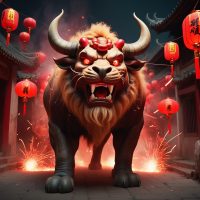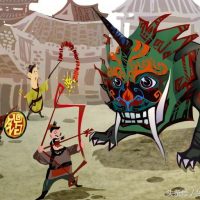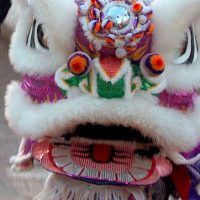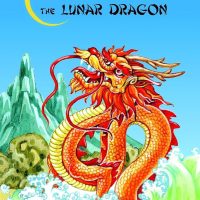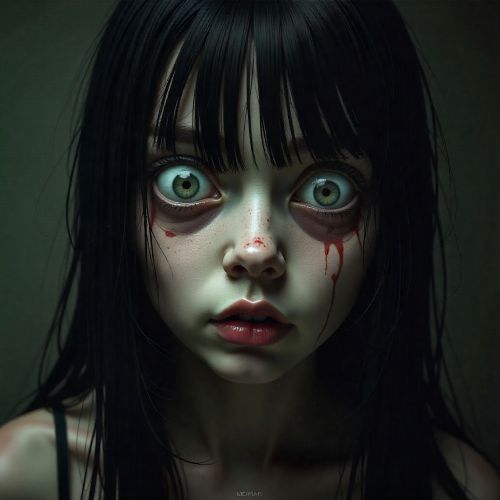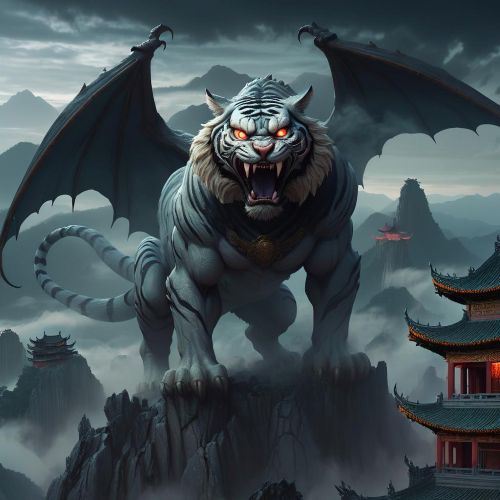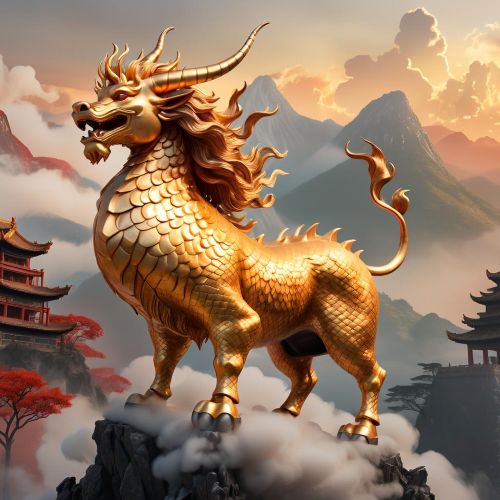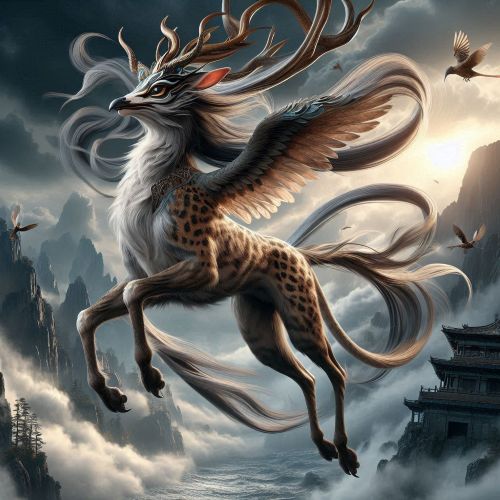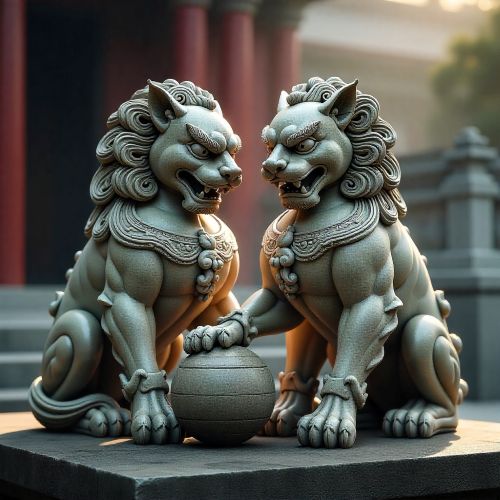Nian : The Beast of the Chinese New Year
Listen
At a glance
| Description | |
|---|---|
| Origin | Chinese Mythology |
| Classification | Gods |
| Family Members | N/A |
| Region | China |
| Associated With | Chinese New Year |
Nian
Introduction
In Chinese mythology, few creatures have left as lasting an impression as Nian, the monstrous beast said to have inspired many of the customs associated with the Lunar New Year. The legend of Nian is not merely a folktale of terror—it is a narrative of resilience, ingenuity, and transformation. According to ancient stories, Nian would emerge at the start of each new year, descending from the mountains or rising from the depths of the sea to attack villages, devouring livestock, crops, and sometimes people. Terrified, the villagers learned to protect themselves through rituals that eventually evolved into the joyous traditions that mark Chinese New Year, or Guo Nian, meaning “passing the year” or “overcoming Nian.” This tale represents humanity’s victory over chaos and the renewal of hope as each year begins.
Physical Traits
Nian’s terrifying image is one of the most distinctive in Chinese folklore. It is often described as a hybrid beast combining features of multiple animals. The most common depiction gives it the body of a bull or ox and the head of a lion, symbolizing both brute strength and ferocity. Its mouth is lined with razor-sharp teeth, and its horns are long and menacing, capable of tearing through anything in its path. Some accounts portray it with scales like a dragon and glowing eyes that pierce the darkness, while others describe a creature as large as an elephant with claws strong enough to uproot trees. Whether imagined as a mountain predator or a sea monster, every version of Nian conveys raw power and primal fear.
These varied depictions across regions highlight the myth’s evolution through oral storytelling. In rural areas, the beast was visualized as an earthbound creature that threatened farmlands, while coastal communities believed it emerged from the sea each winter. Despite these differences, its monstrous appearance served one purpose—to represent the uncontrollable natural forces that ancient people feared most.
Family
In contrast to many mythological beings that belong to divine or royal lineages, Nian is a solitary entity. It has no family, no kin, and no allies. The legends never mention parents, offspring, or companions. This solitude underscores its role as an embodiment of chaos rather than a sentient creature with emotional or social ties. Nian is not a god to be worshipped or a spirit to be appeased through kinship; it is a symbol of primal fear, existing only to be conquered.
Some later interpretations, influenced by regional folklore, hint that Nian may be one among several similar beasts that appear cyclically, but these accounts remain marginal and are not part of traditional mythology. The solitary nature of Nian amplifies its mystery and reinforces its identity as an annual invader—one that humanity must face anew every year.
Other names
The name “Nian” (年) carries profound symbolic meaning. In Chinese, the word itself translates directly to “year,” creating a linguistic and cultural link between the monster and the annual cycle. This dual meaning bridges the mythological and temporal worlds, where defeating Nian each year symbolizes surviving the passage of time and entering a new beginning.
Another common term, “Nian Shou” (年兽), translates to “Year Beast.” In some early texts and folk tales, the creature is also associated with the word “Xi” (夕), which means “Eve” or “night.” This connection gave rise to the term “Chu Xi” (除夕), referring to New Year’s Eve, literally meaning “eliminating Xi.” Though these terms vary slightly in emphasis, they all root the creature firmly within the cosmology of renewal and the cyclical rhythm of life and time.
Powers and Abilities
The legend of Nian centers on its extraordinary strength, ferocity, and destructive power. The beast’s arrival marked catastrophe: it would storm into villages, devour crops, destroy homes, and feed on animals and humans alike. Yet, despite its might, Nian had vulnerabilities that became humanity’s salvation. It was terrified of loud noises, fire, and the color red—a combination of primal fears that villagers learned to exploit.
According to folklore, an old man once advised the villagers to hang red decorations, light lanterns, and ignite firecrackers to drive the creature away. When Nian appeared and was bombarded by noise and flashes of red light, it fled in terror and never returned. This moment marked a turning point: fear turned into celebration, and survival became festivity. Over time, these rituals evolved into the central customs of Chinese New Year, including hanging red banners, setting off fireworks, and staying awake through the night in a practice known as Shou Sui (守岁)—“guarding the year.”
Through this myth, Nian’s powers—and its weaknesses—came to embody the balance between destruction and renewal. Each year’s defeat of Nian symbolizes the victory of light, community, and courage over darkness and fear.
Modern Day Influence
The influence of Nian’s legend on modern Chinese New Year celebrations cannot be overstated. Nearly every major New Year custom—from firecrackers and fireworks to red lanterns, scrolls, and decorations—traces its roots back to the desire to ward off Nian. Even the lion dance, a vibrant performance seen during the festivities, is believed to have originated as a symbolic reenactment of scaring the beast away. The lion, an auspicious and protective symbol in Chinese culture, became a cultural successor to the mythical Nian—both feared and revered.
Today, Nian has been reimagined in countless ways. In literature and animation, it often appears not as a monster but as a misunderstood creature, a reflection of the modern tendency to humanize mythic figures. Children’s books present Nian as a metaphor for fear itself—a challenge to be faced and overcome—while animated films and educational programs use the story to teach the values of courage, unity, and renewal.
Beyond China, the story of Nian has spread across the global Chinese diaspora, inspiring New Year parades and community celebrations that echo its ancient origins. The expression “Guo Nian” (过年) still literally means “to pass the year,” but its etymological root—“to survive Nian”—remains a poetic reminder of the myth that birthed it.
In a broader sense, Nian symbolizes resilience in the face of adversity. It represents the idea that every new year begins with the triumph of light over darkness, courage over fear, and community over isolation. The legend’s transformation—from a tale of horror into a festival of joy—mirrors humanity’s enduring ability to reshape fear into festivity.
Related Images
Source
That’s Qingdao. (2025, August 12). The legend of Nian – History of Chinese New Year. Retrieved from https://www.thatsqingdao.com/chinese-new-year-history-legend-nian/
Wikipedia contributors. (2003, November 16). Nian. Wikipedia. Retrieved November 1, 2025, from https://en.wikipedia.org/wiki/Nian
RedPacket.hk. (2025, May 20). Chinese New Year bedtime stories about the Nian monster and zodiac animals. Retrieved from https://redpacket.hk/chinese-new-year-bedtime-stories-about-the-nian-monster-and-zodiac-animals/
Voi.id. (n.d.). How Chinese people face monsters named Nian. Retrieved from https://voi.id/en/memori/32174
Reddit. (n.d.). The Nian beast (年獸) by me. Associated mythology in. Retrieved November 1, 2025, from https://www.reddit.com/r/mythology/comments/zjzu1d/the_nian_beast_%E5%B9%B4%E7%8D%B8_by_me_associated_mythology_in/
Scribd. (2025, May 21). China’s creation and origin myths: Cross-cultural explorations in oral and written traditions [Book excerpt]. Retrieved from https://www.scribd.com/document/707604386/Mineke-Schipper-editor-Shuxian-Ye-editor-Hubin-Yin-editor-China-s-Creation-and-Origin-Myths-Cross-cultural-Explorations-in-Oral-and-Written
University of Groningen. (2011). The other Neng (Kuiken, Cornelis Jan) [PDF]. Retrieved from https://research.rug.nl/files/33172267/KuikenCJ-TheOtherNeng-herzien2011.pdf
Oxford Academic. (2024, November 14). Appearance politics. Retrieved from https://academic.oup.com/cornell-scholarship-online/book/60139/book-pdf/63248858/upso-9781501777851.pdf
Vault of History. (2025). The Legend of Nian: How a Chinese Monster Shaped the New Year. https://vaultofhistory.com/legend-of-nian/
Yang, L. (2005). Handbook of Chinese Mythology. Oxford University Press.
Birrell, A. (1999). Chinese Mythology: An Introduction. Johns Hopkins University Press.
Wu, C. (2010). Myths and Legends of China. Dover Publications.
Eberhard, W. (1986). A Dictionary of Chinese Symbols: Hidden Symbols in Chinese Life and Thought. Routledge.
Teiser, S. F. (1996). The Ghost Festival in Medieval China. Princeton University Press.
Frequently Asked Questions
What is Nian in Chinese mythology?
Nian is a fearsome monster said to terrorize villages at the end of the lunar year, inspiring many New Year traditions that protect people from harm.
Why is Nian associated with the Lunar New Year?
According to legend, Nian emerged every year to attack humans and livestock, and people used loud sounds, bright lights, and the color red to scare it away — now celebrated as New Year customs.
What does Nian look like?
Nian is often described as a massive creature with sharp horns, powerful claws, and traits of different animals combined into one terrifying form.
How was Nian defeated?
A wise old man taught villagers to use firecrackers, red decorations, and dazzling lanterns — weaknesses that drove Nian back into the mountains and sea.
Is Nian still part of modern celebrations?
Yes. The legend of Nian continues through lion dances, fireworks, and red New Year decorations that symbolize good fortune and protection.


